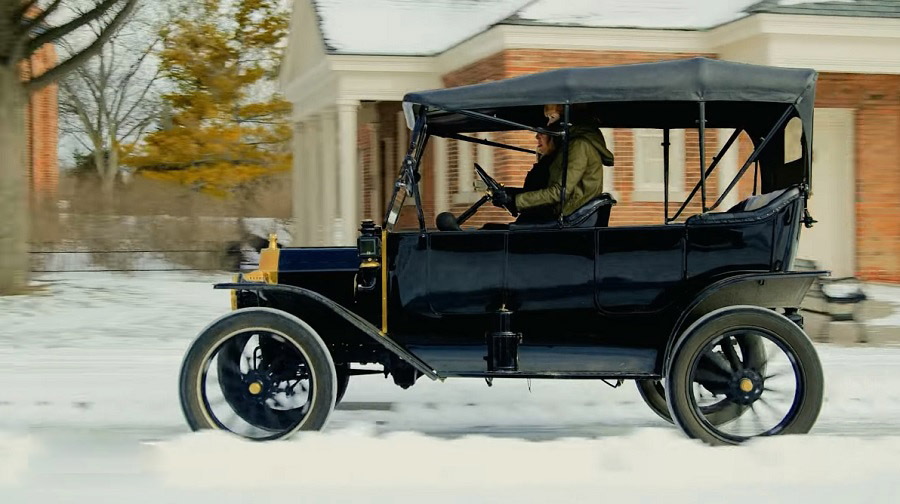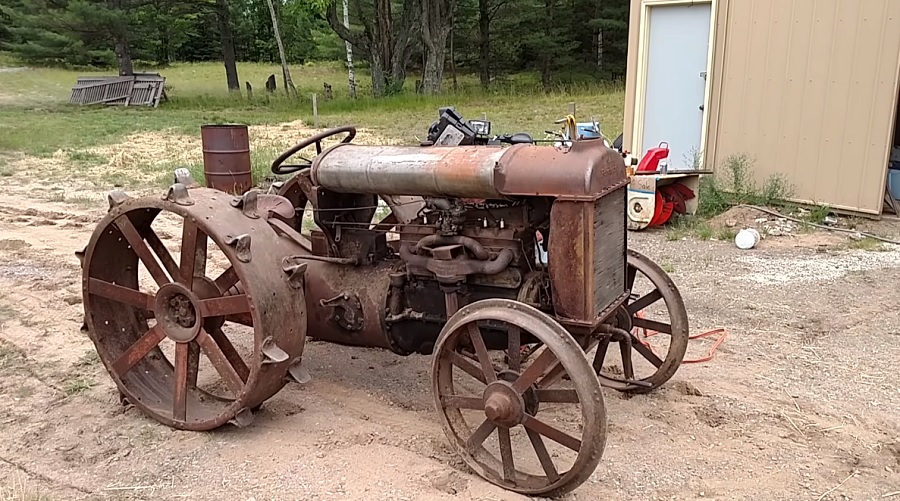The Ford Motor Company based in the US Dearborn, is the fifth-largest automaker worldwide with a turnover of 159.6 billion US dollars and a profit of 7.8 billion US Dollar, after Toyota, Volkswagen, General Motors and Hyundai. The origin of the group is a factory founded by Henry Ford in Detroit in 1903. With the introduction of assembly line production in 1913, Ford brought about a radical change in the emerging auto industry.

History
The Ford Motor Company was Henry Ford’s second start to be independent. In 1899, he founded the Detroit Automobile Company. It was unsuccessful and was reorganized in 1901 under the name Henry Ford Company. In March 1902, there were also inconsistencies in management. Ford was looking for a car for a wide clientele, and the investors, especially William Murphy and Lemuel Bowen, wanted to build expensive, lucrative vehicles. Ford left the first company to bear his name. In August 1902, Henry M. Leland, who later co-founded Lincoln, took over the business and renamed the company Cadillac .
On June 16, 1903, Henry Ford founded another company, Ford Motor Company, in Detroit, Michigan, with $28,000 in capital. He initially named his vehicles according to the alphabet and produced only a few cars a day at his plant on Mack Avenue, where groups of two to three men assembled supplied parts. In the first two years, only about 1700 models of the A, C and AC types were produced.
Model T
After the initial small success, he had the Piquette Avenue Plant built in Detroit in 1904, where the Ford Model T known as “Tin Lizzy” was produced from 1908, which quickly became a sales success. In order to produce the numbers required by the market, the company moved to Highland Park Ford Plant in 1910, where the new technology of assembly line production was perfected by 1913. Henry Ford took over at that time more than 100 years old concept of interchangeable manufacturing of Eli Whitney who also designed the first production line.

With mostly trained personnel, the wagons could be manufactured cheaper and faster. The assembly time for a car chassis was reduced from over twelve hours to just 1.5 hours. In 1918, half of all cars in the United States were a “Model T”. Regarding the car, Ford noted in his memoirs that his customers could get it in any color in the world – as long as it was black. When production was discontinued in 1927, the company had produced over 15 million “Tin Lizzy”. This number was only exceeded by the VW Beetle in early 1972.
Competition
On January 1, 1919, Edsel Ford followed his father to the top of the group, who nevertheless remained in control of the management. The company lost market share in the 1920s. Their stated goal was to build a cheap car that every worker could afford. In order to keep the prices low, no additional equipment was offered. General Motors and other companies had already started to offer cars in other colors, some of them better equipped and also more luxurious. These companies also raised customers’ credit lines so they could afford the more expensive cars. At the time, Ford complained that the loans harmed the economy, but due to market constraints, Ford finally accepted the role of “second winner”.
Fordson
With the production of tractors of the Fordson brand (Henry Ford and Son) the group opened an additional market from 1917. The company expanded its agricultural machinery business considerably by buying New Holland in 1986; the Canadian agricultural machinery manufacturer Versatile was also taken over in 1987. The agricultural machinery division – and thus New Holland and Versatile – was sold to Fiat in 1991. With this sale, Fiat was also assured that it would be able to sell tractors under the Ford brand until 2000.

Aircraft production
In the early 1940s , Ford opened the Willow Run Factory near Ypsilanti (Michigan) to produce B-24 Liberator bomb aircraft. Over 8,600 aircraft were manufactured there under license from the Consolidated Aircraft . After the aircraft production ceased in 1945, the car manufacturer Kaiser Motors took over the plant.

Lab
In 1951 Ford founded a scientific laboratory in Dearborn (Michigan) for basic research. This led to Ford’s remarkable involvement in superconductor research. In 1964, Ford Research Lab made a fundamental breakthrough with the invention of the SQUID superconducting quantum interference device.
In 1955 Ford became a public company .
Other markets
Initially based on the Ford T-model, commercial vehicles were also manufactured, which soon developed into independent models and extended to medium payload classes. In Germany, the production of trucks above the Transit van presented in 1953 was initially discontinued.
In 1973, Ford again presented two truck models for the European market, followed in 1975 by the Transcontinental heavy truck. The lighter models were replaced in 1981 by a uniform successor, which was discontinued without replacement at the end of the 1980s. Since then, Ford has no longer been represented in the truck sector in Europe. In the USA, the truck range, which had been continuous until then, was abandoned except for two series of compact hood trucks, and the heavy truck division was sold to Freightliner .
In 1989 Ford took over the Jaguar company, another ten years later, in 1999, the car production and associated trademark rights from Volvo.

In 1990 Ford sold the subsidiary Ford Aerospace to the Loral Corporation, where it now operates as Space Systems / Loral . In the same year Ford acquired a stake of 10.8% of Cummins Engine.
Demand Crisis
From the year 2000, Ford suffered a serious crisis due to an incorrect model policy in the home market. The group had relied on the high-yield SUVs ( Ford Explorer ) and pick-ups ( Ford F-series ) and neglected the market for compact cars compared to foreign manufacturers. The associated loss of market share has long been ignored. After SUVs, pickups, and other large cars were more difficult to sell due to rising gasoline prices, Ford faced a battle of discounts similar to General Motors and Chrysler because of ongoing capacity utilization problems at its plants.

Restructuring program
The head of the Ford Group, who was in office from 2006 to mid-2014, Alan Mulally, had therefore decided on a drastic restructuring program which cost around 11 billion US dollars and which reduced about 44,000 jobs. In this context, up to 16 production sites were threatened with closure. With a successively newly developed model range, the turnaround was made to more economical vehicles. The trend is increasingly towards compact vehicles in both the mid-range segment and the SUV segment, where the trend is moving away from heavy off-road vehicles towards lighter so-called crossover models such as the Edge and Freestyle models .

In June 2007, the Financial Times reported that Ford plans to sell its UK subsidiaries Jaguar and Land Rover through investment banks Goldman Sachs, Morgan Stanley and HSBC. According to analysts, both brands should be worth around $10 billion. The Indian group Tata Motors took over both companies in March 2008.
In the US car market, Ford was overtaken by Toyota sales in 2007, ranking 3rd in the United States behind General Motors and Toyota. In January 2008, Ford announced a new severance package to help 13,000 more employees depart. After a bad fiscal year 2009, the restructuring of the group and a focus on small cars, a surplus of $2.1 billion was generated in the first quarter of 2010. The same period previous year was a loss of $1.4 billion. At the same time, Ford increases its market share in the United States by 2.7 percentage points to 16.6 percent, ahead of the insolvent General Motors group.
On December 9, 2011, Ford announced that it would distribute dividends again for the first time in five years in March. The reasons are the good economic development of the company and the hope of regaining the trust of investors.
On August 31, 2012, after 109 years of company history, Ford built the 350 millionth car. It is a red Ford Focus that rolled off the assembly line in the Thai factory in Rayong.
Trademarks
In addition to the Ford brand, the Lincoln and Troller automotive brands also belong to the group. The Jaguar and Land Rover brands acquired in 1989 and 2000 were sold to the Tata Group in March 2008. From 1979 to 2015, the Ford Motor Company was involved in Mazda. In recent years, Ford has sold or discontinued other brands that are not directly related to the automotive industry and the spare parts business because of its focus on its core business, such as the car rental company Hertz, or the discount workshop chain Kwik-Fit. In 2010, the battered Swedish automotive brand Volvo, bought in 1999, was sold to Chinese automaker Geely for $1.8 billion.
Commercial vehicles
Ford has also been producing commercial vehicles since 1908, which were initially derived from the Ford Estate and soon developed independently. In addition to the USA, Ford commercial vehicles were produced, sold or manufactured under license in Argentina, Australia, Brazil, Germany, France, Great Britain, India, Canada, the Netherlands, the Philippines, Spain and Turkey – including under the brand Mercury in Canada, in the UK as Ford, from 1933 to 1939 as Fordson, from 1939 to 1957 as Fordson Thames (for car-based vans also Ford Thames), from 1957 to 1965 as Thames and then again as Ford and in Spain under the Ebro brand.

Most of these production and sales branches have now expired. The US activities above the light trucks were sold in 1997 to the Daimler subsidiary Freightliner, which it continues to operate under the brand name Sterling Trucks. In Germany, truck production above the Transit van was abandoned in 1961, experienced a revival since 1973 and ended again in the late 1980s when the remaining manufacturing facilities were sold to Iveco. Ford planned to end its truck business in South America in 2019. Ford has been making Ford Transit van since the 1953, and is currently manufactured in the sixth generation.
Construction Machinery
In addition to cars and commercial vehicles, Ford also temporarily manufactured construction machinery. Both were offered hydraulic excavator with crawler and wheeled chassis and backhoe loaders and wheel loaders. For example, Ford built backhoe loaders of the 4400 and 4500 type in the Danish plant between 1967 and 1974.









